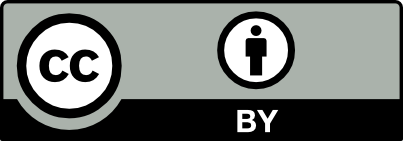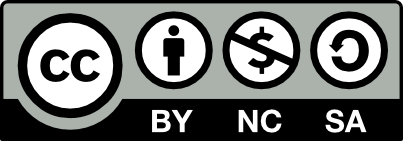What is a Creative Commons License?
What are the elements of a Creative Commons (CC) license to know which to choose for my work?
Answer
Thinking about using a CC license on your work at TCC? Check out these other FAQ and read on below to learn more about these specific copyright licenses!
A CC license might come in handy for making OER textbooks, course materials, and more that you create while working at TCC. You can learn about creating OER with our OER 101 guide:
T here are three layers to a CC license: the legal code, commons deeds, and the “machine readable” version of the license.
here are three layers to a CC license: the legal code, commons deeds, and the “machine readable” version of the license.
- The legal code is all the stuff lawyers care about – it's what is legally enforceable.
- The commons deeds are the easiest to understand layer, because they summarize the legal code.
- The machine readable layer makes it so the licensed works can be retrieved, indexed, and so on by things like search engines and applications. It’s a format that machines can understand to make it easier to discover and retrieve CC licensed works. Here's an example of what the machine readable part does for a Google image search where someone is needing to find a CC-licensed image:

The four license "elements" that make up the various licenses are BY, NC, SA, and ND. These are each of their symbols (in order):




- BY = Attribution = all CC licenses require this element. It means you need to give credit/attribution to the original creator of the work you are reusing.
- NC = NonCommercial = using this means you do not want someone to make money off your work. It can only be used for noncommercial purposes.
- SA = ShareAlike = any adaptations of a work with this element on the license means they must be licensed under a license with this same element.
- ND = NoDerivatives = any users of a work with a license including this element means they cannot share adaptations of the work, only the work verbatim.
There are six possible Creative Commons licenses to choose from in the CC “suite” of options. They make use of the above elements.
 Attribution license or “CC BY” - least restrictive of the licenses. Use the work for even commercial purposes as long as you give credit/attribution to the creator.
Attribution license or “CC BY” - least restrictive of the licenses. Use the work for even commercial purposes as long as you give credit/attribution to the creator.
 Attribution-ShareAlike license or “BY-SA” - use the work even for commercial purposes but give credit/attribution to the creator and any adaptations they share out must be shared with same or compatible license.
Attribution-ShareAlike license or “BY-SA” - use the work even for commercial purposes but give credit/attribution to the creator and any adaptations they share out must be shared with same or compatible license.
 Attribution-NonCommercial license or “BY-NC” - can use and adapt the work for any purpose EXCEPT commercial. Must give attribution to the creator.
Attribution-NonCommercial license or “BY-NC” - can use and adapt the work for any purpose EXCEPT commercial. Must give attribution to the creator.
 Attribution-NonCommercial-ShareAlike license or “BY-NC-SA” - can use and adapt the work for any purpose EXCEPT commercial. Must give credit/attribution to the creator and must be shared with same or compatible license.
Attribution-NonCommercial-ShareAlike license or “BY-NC-SA” - can use and adapt the work for any purpose EXCEPT commercial. Must give credit/attribution to the creator and must be shared with same or compatible license.
 Attribution-NoDerivatives license or “BY-ND” - can use the unadapted work even for commercial purposes as long as you give attribution/credit to the creator.
Attribution-NoDerivatives license or “BY-ND” - can use the unadapted work even for commercial purposes as long as you give attribution/credit to the creator.
 Attribution-NonCommercial-NoDerivatives license or “BY-NC-ND” - the most restrictive license. Can use the unadapted work EXCEPT for commercial purposes and must give credit/attribution to the creator.
Attribution-NonCommercial-NoDerivatives license or “BY-NC-ND” - the most restrictive license. Can use the unadapted work EXCEPT for commercial purposes and must give credit/attribution to the creator.
For help deciding on which one would work for your creation, try the Creative Commons License Chooser:

Adapted from the Creative Commons License Chooser, licensed under a Creative Commons Attribution 4.0 International license.
Beyond the licenses, there are two public domain tools that CC offers. Please note: they are not licenses. They are CC0 and the Public Domain Mark (in order):


- CC0 = where legally possible, this allows creators to dedicate their works to the world’s public domain as much as possible. Some jurisdictions do not legally allow creators to dedicate their works to the public domain. Libraries and museums might use this symbol on works to show they are waiving possible rights they hold over a work in other jurisdictions, but not necessarily because they claim to be the copyright holder.
- The Public Domain Mark = a label that has no legal effect, but it serves to inform others that it is a work known to be in the public domain. It is often used by libraries and museums to show why they are reproducing a work or that something can be reproduced without having to ask permission.
How exceptions and limitations to copyright affect the the CC licenses and other things to keep in mind:
- Creative Commons licenses apply where copyright applies. It functions within copyright law.
- CC licenses are only one type of license. Other permissions/licenses granted by the copyright holder might allow for other uses not addressed under a particular CC license on a work.
- If exceptions and limitations like the TEACH Act, fair use, or provisions for disabilities apply, then any attached license does not need to be considered.
- If something is already in the public domain, copyright would not apply and therefore any attached license is irrelevant (but you can add the Public Domain mark to help inform the public something is in the public domain!)
- Anyone not following a CC license’s terms could be liable for copyright infringement if another exception or limitation does not apply.
- It is NOT recommended to use a CC license on software, as there are other open source software licenses made for this specific purpose and CC licenses don't address certain aspects of sharing software.
- If you create CC-licensed content as a work-for-hire, your employer would only be able to give permission to license the works. They are the copyright holder.
- CC licensed content might incorporate copyrighted content from many creators. For example, someone might use a photograph from someone else within their work of text. The CC license applied by the text author only applies to the text of the work, not the photograph. So, be sure of which license applies to which aspect of a work.
- Intellectual property often has more than one copyright involved. If a book is adapted into a film and the film is the only work CC-licensed, that doesn't mean the book the film was based on has any CC license.
Something to keep in mind:
"Even people who depend upon CC licenses, such as the makers of open educational resources--scholarly materials of all kinds, available free on the web--still sometimes need fair use. That is because most new work refers to existing culture. When that happens, people need to exercise their right of fair use, because most work is not in the copyright-light, fenced-in zone." Reclaiming Fair Use: How to Put Balance Back in Copyright
Happy licensing!
Unless otherwise noted, text and images adapted from Creative Commons Certificate for Educators, Academic Librarians and GLAM by Creative Commons, licensed under a CC Attribution 4.0 International (CC BY 4.0) license.
FAQ and associated GIFs by TCC Library are licensed under a Creative Commons Attribution 4.0 International (CC BY 4.0) License.
Links & Files
- About CC Licenses Opens in new window
- Open Educational Resources--OER: Creative Commons Licensing Opens in new window
- Unit 3: Anatomy Of A CC License - Creative Commons Certificate for Educators, Academic Librarians and GLAM Opens in new window
- Considerations for licensors and licensees Opens in new window


